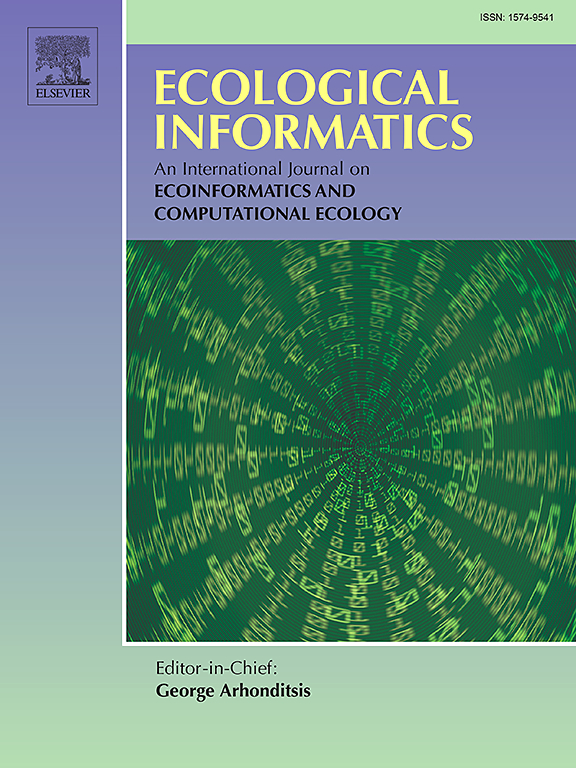海岸带池塘功能分类重建:多特征遥感集成
IF 7.3
2区 环境科学与生态学
Q1 ECOLOGY
引用次数: 0
摘要
池塘水面在海岸带生态可持续发展中起着至关重要的作用。然而,在这些地区,不同类型的PWS存在显著差异,并且缺乏一个通用的池塘分类系统,使PWS特征的分析变得复杂。为了解决这一瓶颈,本研究引入了一种精细化的海岸带PWS分类系统,包括陆侧聚类养殖池塘(LCAP)、海洋养殖池塘(MAS)、盐田(SP)、景观池塘(LP)和自然池塘(NP)。基于谷歌Earth Engine,利用Sentinel-2图像建立了一种多特征融合面向对象(MFFO) PWS方法。因此,在中国江苏海岸带形成了10 m分辨率的PWS分类数据。结果表明:(1)PWS的总表面积为904.01 km2,占研究面积的7.08%,总体精度达到83.18%。PWS的功能类型可分为水产养殖、景观美化、蓄水和盐干燥。(2)不同PWS功能类型在遥感特征和地理格局上存在显著差异。遥感特征表明,LCAP、MAS和SP在不同光谱波段差异较大,NP在形状特征上差异较大,LP在空间分布上差异较大。从地理上看,LCAP和SP主要分布在沿海泥滩,LP主要分布在城市,NP主要分布在农村和山区,MAS主要分布在海洋表面。综上所述,本研究建立的PWS分类体系和数据产品揭示了PWS“功能类型-遥感特征-地理格局”之间的多元关系,为阐明PWS的生态功能价值和海岸带合理规划提供了重要依据。本文章由计算机程序翻译,如有差异,请以英文原文为准。
Reconstructing coastal ponds functional classification: Integration of multi-feature remote sensing
Pond water surfaces (PWS) play a crucial role in the ecological sustainability and development of coastal zones. However, in these areas, different types of PWS have significant differences, and the absence of a universal pond classification system complicates the analysis of PWS characteristics. To address this bottleneck, this study introduces a refined PWS classification system for coastal zones, including landside clustering aquaculture ponds (LCAP), marine aquaculture ponds (MAS), salt pans (SP), landscape ponds (LP), and natural ponds (NP). A multifeatured fusion object-oriented (MFFO) method for PWS was established using Sentinel-2 images, based on the Google Earth Engine. Consequently, 10-m resolution PWS classification data were formed in the coastal zone of Jiangsu, China. Results showed that: (1) The total surface area of PWS was 904.01 km2, which accounted for 7.08 % of the study area, reaching 83.18 % overall accuracy. The functional types of PWS can be categorized as aquaculture, landscaping, water storage, and salt drying. (2) Regarding different PWS functional types, significant differences were demonstrated in terms of remote sensing features and geographical patterns. Remote sensing features revealed that LCAP, MAS, and SP differ greatly across various spectral bands, whereas NP varied substantially in shape characteristics, and LP exhibited distinct spatial distribution. Geographically, LCAP and SP were mostly distributed in coastal mudflats, LP were mainly situated in cities, NP were largely distributed in rural and mountainous areas, and MAS were situated on the ocean surface. Above all, the PWS classification system and data products developed in this study reveal the diverse relationships among “functional types-remote sensing features-geographical patterns” regarding PWS, implicating a crucial foundation for clarifying the ecological functional value of PWS and appropriate planning in the coastal zone.
求助全文
通过发布文献求助,成功后即可免费获取论文全文。
去求助
来源期刊

Ecological Informatics
环境科学-生态学
CiteScore
8.30
自引率
11.80%
发文量
346
审稿时长
46 days
期刊介绍:
The journal Ecological Informatics is devoted to the publication of high quality, peer-reviewed articles on all aspects of computational ecology, data science and biogeography. The scope of the journal takes into account the data-intensive nature of ecology, the growing capacity of information technology to access, harness and leverage complex data as well as the critical need for informing sustainable management in view of global environmental and climate change.
The nature of the journal is interdisciplinary at the crossover between ecology and informatics. It focuses on novel concepts and techniques for image- and genome-based monitoring and interpretation, sensor- and multimedia-based data acquisition, internet-based data archiving and sharing, data assimilation, modelling and prediction of ecological data.
 求助内容:
求助内容: 应助结果提醒方式:
应助结果提醒方式:


